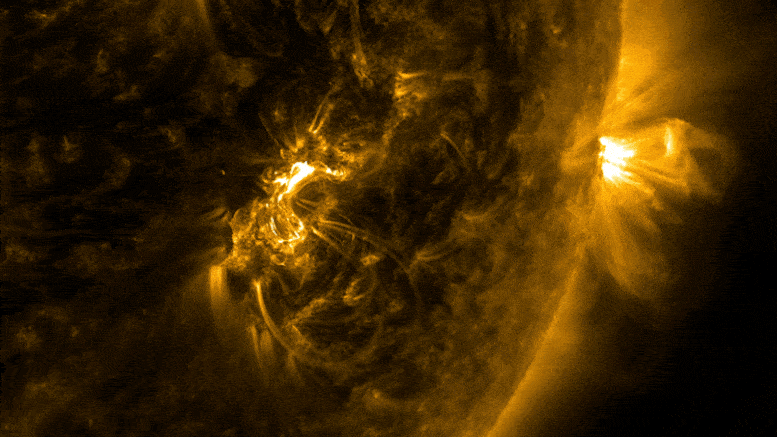
An X-class solar flare (X9.3) emitted on September 6, 2017, and captured by NASA’s Solar Dynamics Observatory in extreme ultraviolet light. Credit: NASA/GSFC/SDO
Scientists analyze sunquakes to pinpoint flare energy source, perhaps predict flare severity.
Solar flares are violent explosions on the sun that fling out high-energy charged particles, sometimes toward Earth, where they disrupt communications and endanger satellites and astronauts.
But as scientists discovered in 1996, flares can also create seismic activity — sunquakes — releasing impulsive acoustic waves that penetrate deep into the sun’s interior.
While the relationship between solar flares and sunquakes is still a mystery, new findings suggest that these “acoustic transients” — and the surface ripples they generate — can tell us a lot about flares and may someday help us forecast their size and severity.
A team of physicists from the United States, Colombia, and Australia has found that part of the acoustic energy released from a flare in 2011 emanated from about 1,000 kilometers beneath the solar surface — the photosphere — and, thus, far beneath the solar flare that triggered the quake.
The results, reported in The Astrophysical Journal Letters on September 21, 2020, come from a diagnostic technique called helioseismic holography, introduced in the late 1900s by French scientist Franoise Roddier and extensively developed by U.S. scientists Charles Lindsey and Douglas Braun, now at NorthWest Research Associates in Boulder, Colorado, and co-authors of the paper.
Helioseismic holography allows scientists to analyze acoustic waves triggered by flares to probe their sources, much as seismic waves from megaquakes on Earth allow seismologists to locate their epicenters. The technique was first applied to acoustic transients released from flares by a graduate student in Romania, Alina-Catalina Donea, under the supervision of Lindsey and Braun. Donea is now at Monash University in Melbourne, Australia.
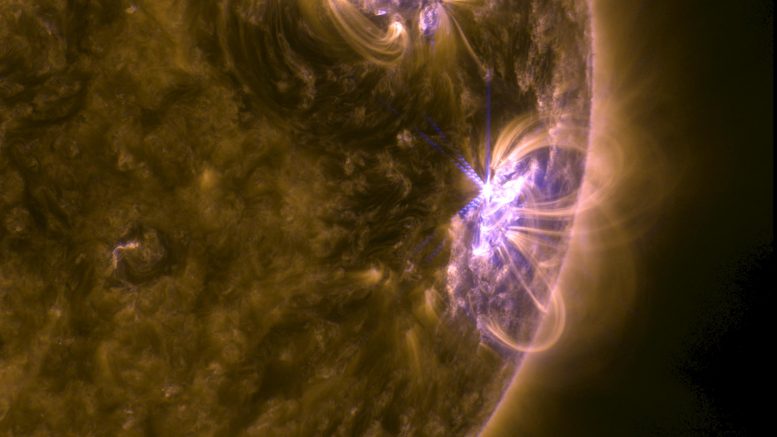
NASA’s Solar Dynamics Observatory captured this image of a medium-class (M8.1) solar flare (bright area at right) on September 8, 2017. The image blends two different wavelengths of extreme ultraviolet light. Credit: NASA/GSFC/SDO
“It‘s the first helioseismic diagnostic specifically designed to directly discriminate the depths of the sources it reconstructs, as well as their horizontal locations,” Braun said.
“We can’t see the sun’s inside directly. It is opaque to the photons that show us the sun’s outer atmosphere, from where they can escape to reach our telescopes,” said co-author Juan Camilo Buitrago-Casas, a University of California, Berkeley, doctoral student in physics from Colombia. “The way we can know what happens inside of the sun is via seismic waves that make ripples on the solar surface similar to those caused by earthquakes on our planet. A big explosion, such as a flare, can inject a powerful acoustic pulse into the sun, whose subsequent signature we can use to map its source in some detail. The big message of this paper is that the source of at least some of this noise is deeply submerged. We are reporting the deepest source of acoustic waves so far known in the sun.”
How sunquakes produce ripples on the sun’s surface
The acoustic explosions that cause sunquakes in some flares radiate acoustic waves in all directions, primarily downward. As the downward-traveling waves move through regions of ever-increasing temperature, their paths are bent by refraction, ultimately heading back up to the surface, where they create ripples like those seen after throwing a pebble in a pond. The time between the explosion and the arrival of the ripples is about 20 minutes.
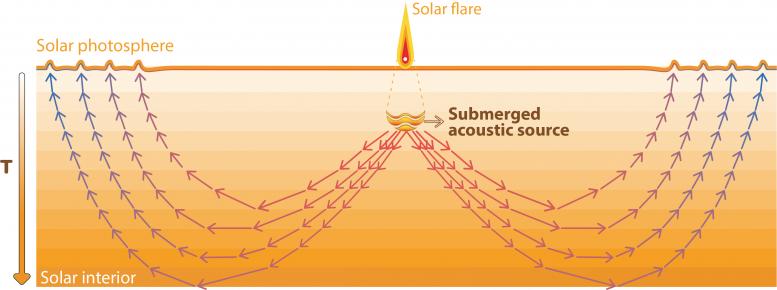
Solar flares trigger acoustic waves (sunquakes) that travel downward but, because of increasing temperatures, are bent or refracted back to the surface, where they produce ripples that can be seen by Earth-orbiting observatories. Solar physicists have discovered a sunquake generated by an impulsive explosion 1,000 kilometers below the flare (top), suggesting that the link between sunquakes and flares is not simple. Credit: UC Berkeley graphic by Juan Camilo Buitrago-Casas
“The ripples, then, are not just a surface phenomenon, but the surface signature of waves that have gone deep beneath the active region and then back up to the outlying surface in the succeeding hour,” Lindsey said. Analyzing the surface ripples can pinpoint the source of the explosion.
“It has been widely supposed that the waves released by acoustically active flares are injected into the solar interior from above. What we are finding is the strong indication that some of the sources is far beneath the photosphere,” said Juan Carlos Martínez Oliveros, a solar physics researcher at UC Berkeley’s Space Sciences Laboratory and a native of Colombia. “It seems like the flares are the precursor, or trigger, to the acoustic transient released. There is something else happening inside the sun that is generating at least some part of the seismic waves.”
“Using an analogy from medicine, what we (solar physicists) were doing before is like using X-rays to look at one snapshot of the interior of the sun. Now, we are trying to do a CAT scan, to view the solar interior in three dimensions,” added Martínez Oliveros.
The Colombians, including students Ángel Martínez and Valeria Quintero Ortega at Universidad Nacional de Colombia, in Bogotá, are co-authors of the ApJ Letters paper with their supervisor, Benjamín Calvo-Mozo, associate professor of astronomy.
“We have known about acoustic waves from flares for a little over 20 years now, and we have been imaging their sources horizontally since that time. But we have only recently discovered that some of those sources are submerged below the solar surface,” said Lindsey. “This may help explain a great mystery: Some of these acoustic waves have emanated from locations that are devoid of local surface disturbances that we can directly see in electromagnetic radiation. We have wondered for a long time how this can happen.”
A seismically active sun
For more than 50 years, astronomers have known that the sun reverberates with seismic waves, much like the Earth and its steady hum of seismic activity. This activity, which can be detected by the Doppler shift of light emanating from the surface, is understood to be driven by convective storms that form a patchwork of granules about the size of Texas, covering the sun’s surface and continually rumbling.
Time-lapse sequence of the July 30, 2011, solar flare observed by NASA’s SolarDynamics Observatory. The left frame shows visible light emissions in amber and excess extreme ultraviolet emissions in red. The right frame shows the line-of-sight Doppler velocity of the solar surface emissions. Between 20 to 40 minutes following the impulsive phase of the flare (IP on timeline), a strong acoustic disturbance released downward into the underlying solar interior has refracted back to the outlying surface, tens of thousands of kilometers from the site of the flare, to elicit outwardly propagating surface ripples (right frame). The movie is 200 times faster than real time; the ripples are amplified by a factor of three in the right frame compared to the left. Credit: Charles Lindsey
Amid this background noise, magnetic regions can set off violent explosions releasing waves that make the spectacular ripples that then appear on the sun’s surface in the succeeding hour, as discovered 24 years ago by astronomers Valentina Zharkova and Alexander Kosovichev.
As more sunquakes have been discovered, flare seismology has blossomed, as have the techniques to explore their mechanics and their possible relationship to the architecture of magnetic flux underlying active regions.
Among the open questions: Which flares do and don’t produce sunquakes? Can sunquakes occur without a flare? Why do sunquakes emanate primarily from the edges of sunspots, or penumbrae? Do the weakest flares produce quakes? What is the lower limit?
Until now, most solar flares have been studied as one-offs, since strong flares, even during times of maximum solar activity, may occur only a few times a year. The initial focus was on the largest, or X-class, flares, classified by the intensity of the soft X-rays they emit. Buitrago-Casas, who obtained his bachelor’s and master’s degrees from Universidad Nacional de Colombia, teamed up with Lindsey and Martínez Oliveros to conduct a systematic survey of relatively weak solar flares to increase their database, for a better understanding of the mechanics of sunquakes.
Of the 75 flares captured between 2010 and 2015 by the RHESSI satellite — a NASA X-ray satellite designed, built, and operated by the Space Sciences Laboratory and retired in 2018 — 18 produced sunquakes. One of Buitrago-Casas’s acoustic transients, the one released by the flare of July 30, 2011, caught the eyes of undergraduate students Martínez, now a graduate student, and Quintero Ortega.
“We gave our student collaborators at the National University the list of flares from our survey. They were the first ones who said, ‘Look at this one. It’s different! What happened here?’” Buitrago-Casas said. “And so, we found out. It was super exciting!”
Martínez and Quintero Ortega are the first authors on a paper describing the extreme impulsivity of the waves released by that flare of July 30, 2011, that appeared in the May 20, 2020, issue of The Astrophysical Journal Letters. These waves had spectral components that gave the researchers unprecedented spatial resolution of their source distributions.
Thanks to superb data from NASA’s Solar Dynamics Observatory satellite, the team was able to pinpoint the source of the explosion that generated the seismic waves 1,000 kilometers below the photosphere. This is shallow, relative to the sun’s radius of nearly 700,000 kilometers, but deeper than any previously known acoustic source in the sun.
A source submerged below the sun’s photosphere with its own morphology and no conspicuous directly overlying disturbance in the outer atmosphere suggests that the mechanism that drives the acoustic transient is itself submerged.
“It may work by triggering a compact explosion with its own energy source, like a remotely triggered earthquake,” Lindsey said. “The flare above shakes something beneath the surface, and then a very compact unit of submerged energy gets released as acoustic sound,” he said. “There is no doubt that the flare is involved, it’s just that the existence of this deep compact source suggests the possibility of a separate, distinctive, compact, submerged energy source driving the emission.”
About half of the medium-sized solar flares that Buitrago-Casas and Martínez Oliveros have cataloged have been associated with sunquakes, showing that they commonly occur together. The team has since found other submerged sources associated with even weaker flares.
The discovery of submerged acoustic sources opens the question of whether there are instances of acoustic transients being released spontaneously, with no surface disturbance, or no flare, at all.
“If sunquakes can be generated spontaneously in the sun, this might lead us to a forecasting tool, if the transient can come from magnetic flux that has yet to break the sun’s surface,” Martínez Oliveros said. “We could then anticipate the inevitable subsequent emergence of that magnetic flux. We may even forecast some details about how large an active region is about to appear and what type — even, possibly, what kinds of flares — it might produce. This is a long shot, but well worth looking into.”
References:
“Submerged Sources of Transient Acoustic Emission from Solar Flares” by Charles Lindsey, J. C. Buitrago-Casas, Juan Carlos Martínez Oliveros, Douglas Braun, Angel D. Martínez, Valeria Quintero Ortega, Benjamín Calvo-Mozo and Alina-Catalina Donea, 21 September 2020, The Astrophysical Journal Letters.
DOI: 10.3847/2041-8213/abad2a
“Ultra-impulsive Solar Flare Seismology” by Angel D. Martínez, Valeria Quintero Ortega, J. C. Buitrago-Casas, Juan Carlos Martínez Oliveros, Benjamín Calvo-Mozo and Charles Lindsey, 22 May 2020, The Astrophysical Journal Letters.
DOI: 10.3847/2041-8213/ab9173

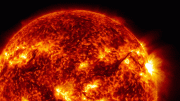
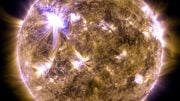
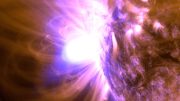
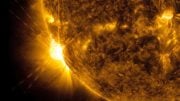
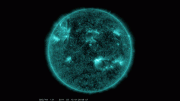
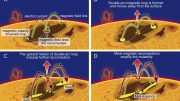
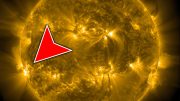

Be the first to comment on "Scientists Analyze Sunquakes: Can Ripples on the Sun Help Predict Solar Flares?"